The 1996 quarter is an interesting coin regarding history, value, and composition. Thus, it is not surprising that some people are interested in adding this coin to their collection.
Would you like to know more? If yes, discover interesting facts about the 1996 Washington Quarter.
What Is the 1996 Washington Quarter Made Of?
The 1996 quarter is made of 25% nickel and 75% copper. Its core is made of pure nickel while it is clad with nickel. The diameter of the 1996 quarter is 24.30 millimeters and the weight is 5.67 grams. The same composition and specifications have been used from 1965 until now.
Before 1965, most US coins were made of 90% silver. These coins include the dime, half dollar, and of course, the quarter dollar. Because of the rising price of silver, there came a time when silver became more expensive than the face value of the coin it represents. Plus, more and more people are hoarding silver coins to earn from them.
Thus, through the Coinage Act of 1965, the silver quarter became the cupro-nickel quarter. Although, there are still a few quarters made with silver — quarters made for collectors rather than the public.
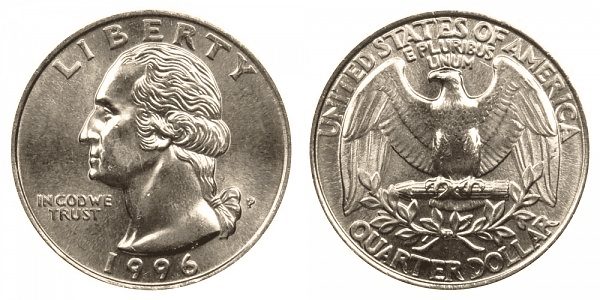
In terms of design, the 1996 Washington Quarter followed the same design used when the Washington Quarter was first produced. The obverse features Washington facing to the left. Inscriptions include 1996, IN GOD WE TRUST, and LIBERTY.
On the reverse, you’ll find the eagle that represents strength, the bundle of arrows that represent the readiness of the United States to defend itself, and the olive branch that represents peace. Inscriptions include QUARTER DOLLAR, UNITED STATES OF AMERICA, and E PLURIBUS UNUM.
The beginning of the Washington Quarter is quite interesting. As early as 1924, a Bicentennial Commission was already established to plan how to celebrate Washington’s momentous 200th birth anniversary. In 1930, a new Bicentennial Commission was created. The Commission suggested using the half-dollar and adding Washington’s image to it. However, the quarter coin was considered instead in a twist of fate.
John Flanagan’s design was chosen through a design competition, and through much debate, the Washington Quarter was eventually born.
1996 Washington Quarter Varieties
The 1996 Washington Quarter has four varieties, which differ based on their mint mark, composition, and nature of the strike. Take a look at this table to gain more ideas:
| Variety | Mint Location | Mintage |
| 1996 P Washington Quarter | Philadelphia | 925,040,000 |
| 1996 D Washington Quarter | Denver | 906,868,000 |
| 1996 S Proof Washington Quarter | San Francisco | 1,750,244 |
| 1996 S Silver Proof Washington Quarter | San Francisco | 775,021 |
| Total | 1,834,433,265 |
The San Francisco Mint produced cupronickel and silver proof quarter coins with more than 2 million pieces. On the other hand, the Philadelphia and Denver Mint worked together to produce more than 1.8 billion regular quarter coins for circulation.
The mintage figure for quarters in 1996 was lower than what was produced in 1995 but higher than in 1997.
Let’s now take a deeper look at each of the 1996 quarter varieties:
1996 P Washington Quarter
Year of minting: 1996
Mint Mark: P
Place of minting: Philadelphia
Quantity produced: 925,040,000
Face Value: $0.25 (twenty-five cents)
Price: $0.30 and $0.85 (circulated condition)
Mass: 5.67 grams
Diameter: 24.30 mm
Edge: Reeded
Designer: John Flanagan
Composition: 75% Copper, 25% Nickel
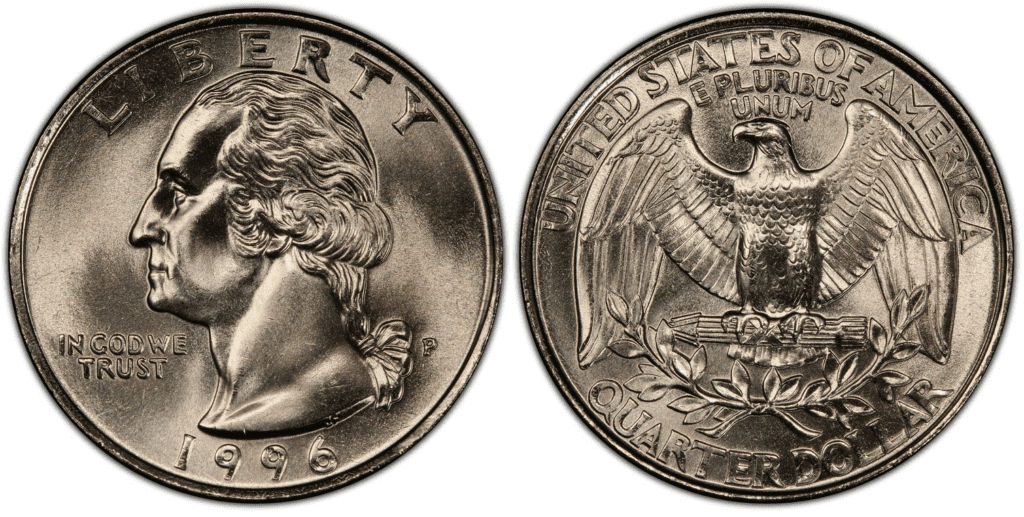
The Philadelphia Mint produced more than 925 million quarters in 1996. It produced the most number of quarters in that year. With a mintage like this, it is easy to find 1996-P quarters up to MS65 condition.
1996 D Washington Quarter
Year of minting: 1996
Mint Mark: D
Place of minting: Denver
Quantity produced: 906,868,000
Face Value: $0.25 (twenty-five cents)
Price: $0.30 and $0.85 (circulated condition)
Mass: 5.67 grams
Diameter: 24.30 mm
Edge: Reeded
Designer: John Flanagan
Composition: 75% Copper, 25% Nickel
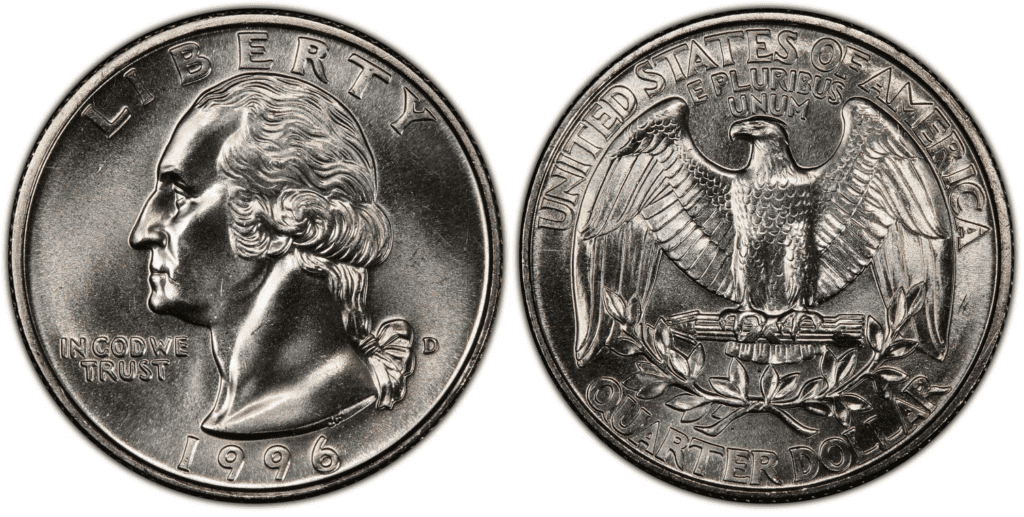
Denver Mint’s mintage figure for the quarter was also high, reaching more than 900 million. Like the 1996-P quarter, the 1996-D is easy to obtain up to MS67 condition. However, quarters with a grade of MS68 and above are difficult to find.
1996 S Proof Washington Quarter
Year of minting: 1996
Mint Mark: S
Place of minting: San Francisco
Quantity produced: 1,750,244
Face Value: $0.25 (twenty-five cents)
Price: $13 or more (uncirculated condition)
Mass: 5.67 grams
Diameter: 24.30 mm
Edge: Reeded
Designer: John Flanagan
Composition: 75% Copper, 25% Nickel
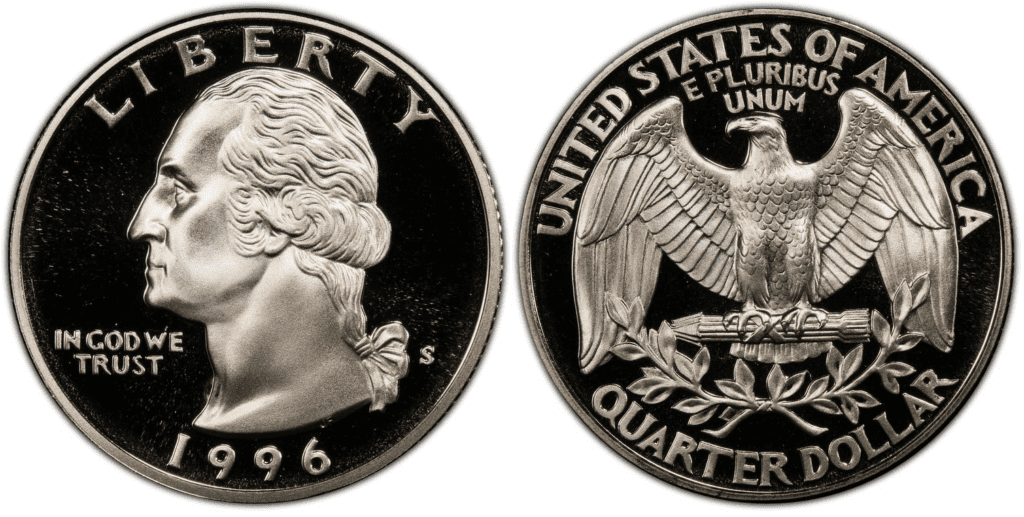
Today, there are plenty of 1996-S quarter proof coins. Even in the highest grade of PR70 Deep Cameo, the 1996-S quarters are abundant and easy to find.
1996 S Silver Proof Washington Quarter
Year of minting: 1996
Mint Mark: S
Place of minting: San Francisco
Quantity produced: 775,021
Face Value: $0.25 (twenty-five cents)
Price: $21 or more (uncirculated condition)
Mass: 6.30 grams
Diameter: 24.30 mm
Edge: Reeded
Designer: John Flanagan
Composition: 90% silver, 10% copper
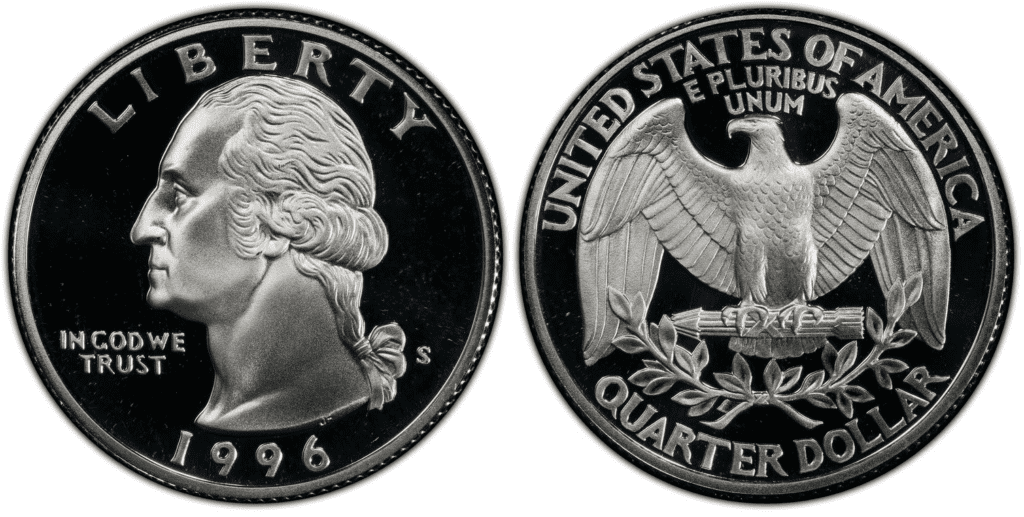
The San Francisco Mint produced a special silver version of its quarter proof coins. The silver-proof coins are heavier and more valuable. Less than 800 thousand examples were produced in 1996.
List Of 1996 Washington Quarter Errors
There were more than 1.8 billion 1996 quarters produced. So, there’s a bigger possibility that an error coin would occur. Here are some examples:
Broadstrike error
The broad strike error caused the coin to spread out when the die struck the coin. The loose hold of the die collar causes this.
Here’s what a broad strike error looks like on a 1996 Washington quarter:
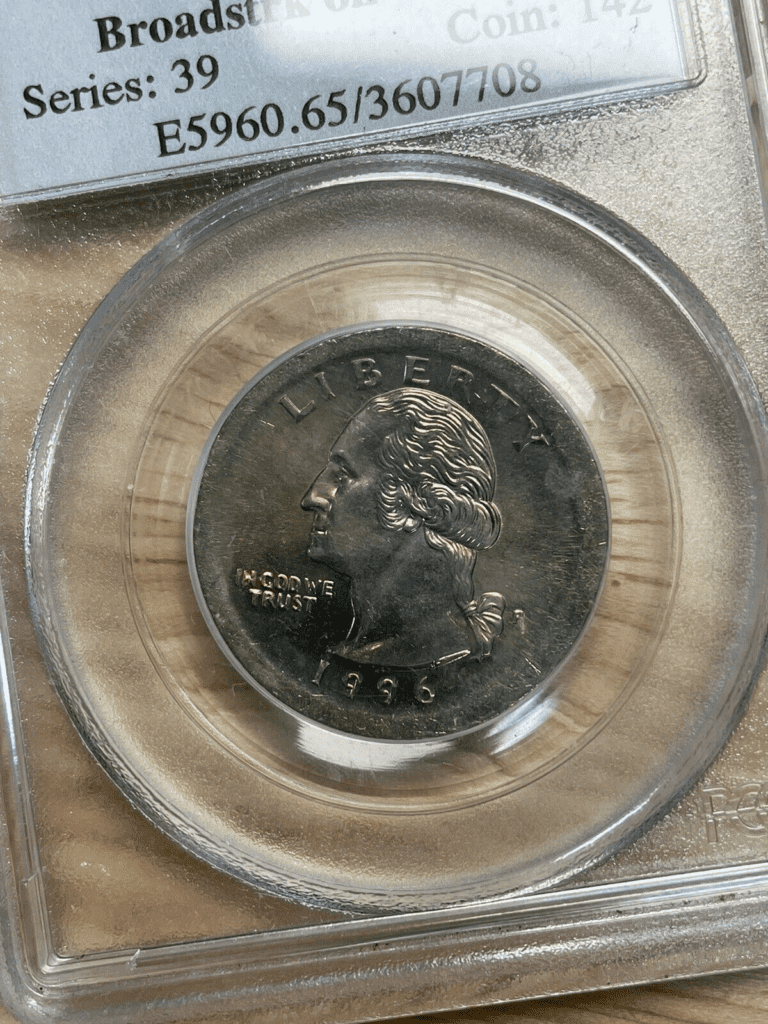
Strike-through error
When the die strikes through a foreign object, the coin has some distortion. The foreign object can be cloth, grease, metal clippings, dust, and dirt.
Here’s an example of what happens to a coin due to a strike-through error:
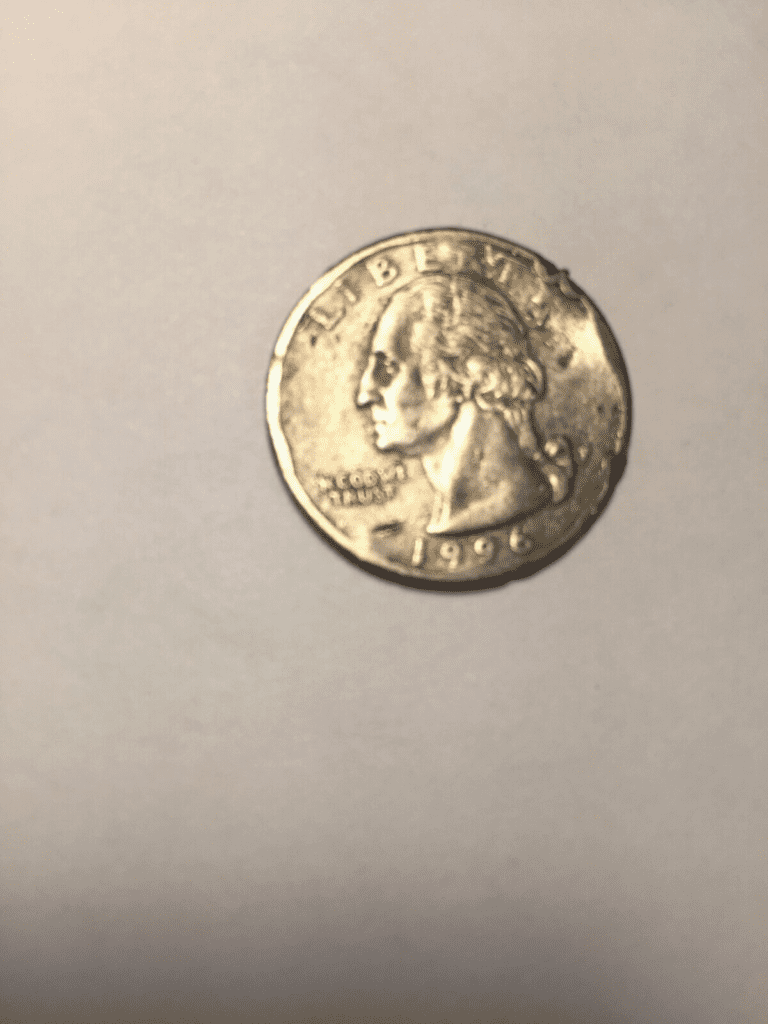
Annealing error
It goes through the annealing process to give the luster and beautiful color to the Washington Quarter. However, an annealing error occurs when the coin is in the annealing drum for too long. This causes the coin to have an uneven color.
Here’s an example:

How Much Is 1996 Washington Quarter Worth Today?
The 1996 Washington quarter has a face value of 25 cents while its melt value is $0.0576. Circulated 1996 Washington quarter is just below 1 dollar.
Nevertheless, some 1996 Washington quarters are worth a lot more money. To give you an idea, take a look at this table of auction records:
| Coin | Condition | Grade | Sold date | Sold by | Value |
| 1996 D Washington Quarter | Superb Gem Uncirculated | MS 68 | March 17, 2013 | Heritage Auctions | $447 |
| 1996 P Washington Quarter | Uncirculated | MS 60 | July 30, 2003 | Bowers & Merena | $6,900 |
| 1996 S Proof Washington Quarter | Perfect Uncirculated | PR 70 – Deep Cameo | September 30, 2003 | Heritage Auctions | $719 |
| 1996 S Silver Proof Washington Quarter | Perfect Uncirculated | PR 70 – Deep Cameo | January 16, 2006 | David Lawrence RC | $334 |
How Does The Grading System Work?
The 1996 Washington quarter is graded by using the Sheldon Scale.
Professional numismatists joined in the 1970s and established CoinGrading standards, known as the Sheldon Scale. These numismatists now assign grades at key places on the seventy-point scale, using the most regularly utilized numeric points in conjunction with the original adjective grade. The following are the most common coin grades:
- (P-1) Poor – Indistinguishable and probably damaged; if used, must have a date and mintmark; otherwise, rather battered.
- (FR-2) Fair – Nearly smooth, but without the damage that a coin graded Poor often possesses. The coin must have enough detail to be identified.
- (G-4) Fair – Inscriptions have merged into the rims in some areas, and important elements have been mostly erased.
- (VG-8) Very Good- A little weathered, but all primary design elements are visible, albeit faintly. There is little, if any, central detail left.
- (F-12) Good – The item is very worn, yet the wear is even, and the overall design details stand out clearly. Rims are almost completely isolated from the field.
- (VF-20) Very Fine – Moderately weathered, with some finer features still visible. The motto or all letters of LIBERTY are readable. Both sides of the coin have entire rims separated from the field.
- (EF-40) Extremely Fine – Gently used; all gadgets are visible, and the most important ones are bold. The finer details are bold and clear; however, light wear may be seen.
- (AU-50) Uncirculated – Slight evidence of wear on the coin’s design’s high points; it may have contact marks; eye appeal should be adequate.
- (AU-58) Uncirculated Choice – Slight traces of wear, no severe contact marks, almost full mint shine, and great eye appeal.
- (MS-60) Mint State Basal – Strictly uncirculated; no indication of wear on the coin’s highest points, but an unsightly coin with reduced luster, visible contact marks, hairlines, and other flaws.
- (MS-63) Mint State Acceptable – Uncirculated, but with contact scratches and nicks, little reduced shine, but otherwise appealing appearance. The strike is weak to average.
- (MS-65) Mint State Choice – Uncirculated with great mint shine, little contact blemishes, and exceptional eye appeal. The strike is unusually severe.
- (MS-68) Mint State Premium Quality – Uncirculated with superb luster, no obvious contact marks to the naked eye, and exceptional eye appeal. The strike is quick and appealing.
- (MS-69) Almost Perfect Mint State – Uncirculated with perfect brilliance, a sharp and appealing strike, and extremely good eye appeal. A near-perfect coin with minor imperfections in the planchet, strike, and contact markings (seen only under 8x magnification).
- (MS-70) Mint State Perfect – Under 8x magnification, no tiny imperfections are discernible; the strike is crisp, and the coin is perfectly centered on a beautiful planchet. Rarely seen on a coin, this coin is bright and whole, with original luster and exceptional eye appeal.
Where To Buy Or Sell 1996 Washington Quarter?
The 1996 Washington Quarter is available online and in brick-and-mortar stores. Online websites such as eBay, Amazon, and Etsy are platforms that allow you to buy and sell coins. Some websites specialize in selling coins, such as JM Bullion, USA Coin Book, and Coin Appraiser.
Offline, you can go to coin shops and private coin dealers. There might also be some antique stores and pawn shops that offer Washington quarters. Check out auction houses as well, and if possible, join clubs of coin collectors to gain more insights.
FAQs
Are there any errors in the 1996 quarter?
Yes, there are different errors found in the 1996 quarters. Some include doubled die, weak strike, clipped planchet, annealing error, and repunched mintmarks.
Is a 1996 quarter silver?
Yes, there’s a 1996 quarter version that is made of silver. There are less than 800 thousand silver quarter-proof coins that the San Francisco Mint produced in 1996.
How much is a 1996 Quarter worth today?
Regular and ordinary 1996 quarter coins are traded at their face value. Circulated 1996 quarters are sold for less than a dollar. However, the 1996 quarters have special characteristics, which made them rare and unique. These types of quarters are more valuable. For example, a 1996 P Washington Quarter with a grade of MS60 was sold for $6,900 on July 30, 2003.
